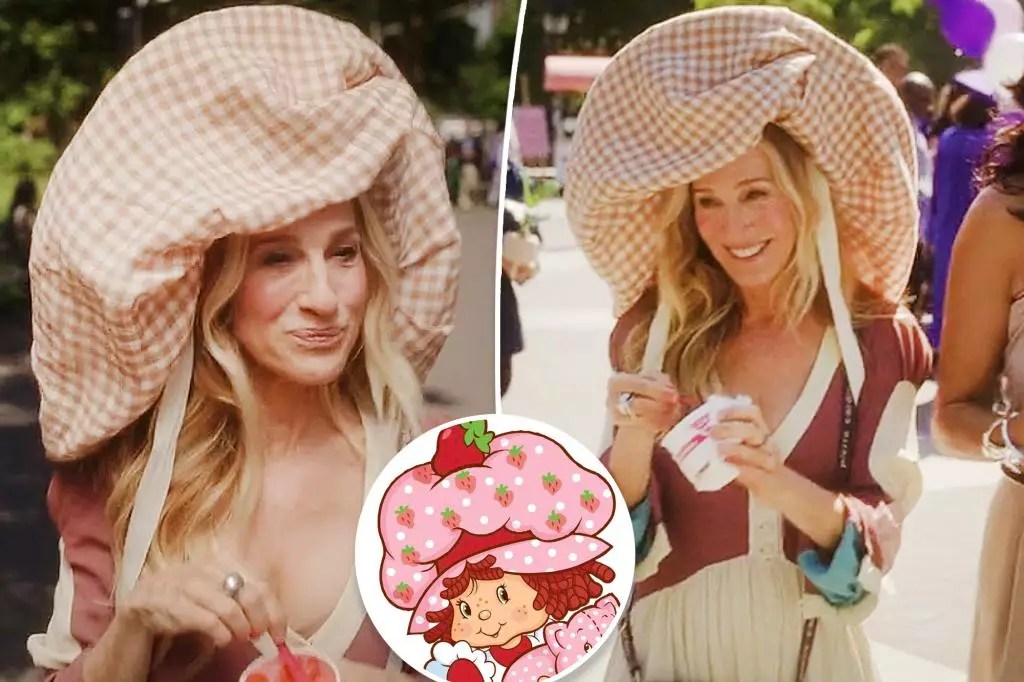In the world of fashion, few characters resonate quite like Carrie Bradshaw of “Sex and the City” fame. With the revival “And Just Like That” stirring the pot of nostalgia, the character continues to push the boundaries of style. Recently, a particular hat worn by Sarah Jessica Parker—or should we call her Carrie?—in the show’s third season has sparked a fervent debate among fans and fashion aficionados alike. This floppy, gingham piece from designer Maryam Keyhani not only evokes a whimsical aesthetic but also brings into question the line between avant-garde and absurd.
The debate was heightened when the episode featuring the controversial piece finally aired on May 29. Described as “unhinged” and reminiscent of the cartoonish Strawberry Shortcake, the hat quickly caught the eyes—both approving and bewildered—of viewers. With Parker strolling through Washington Square Park in a vibrant Ossie Clark dress paired with Dr. Scholl’s wooden slides, the ensemble was both a nod to retro flair and an experimental risk.
Artistry or Absurdity?
Parker’s take on the hat was unequivocally personal. During a video interview with *US Weekly*, she expressed her desire to wear “the hat that wanted to be on my head,” reflecting her artistic engagement with fashion. But when does personal expression transition from inspired artistry to a fashion misfire? Parker herself humorously noted that hats can act as “punctuation points” to an outfit, suggesting that the hat was an essential addition to her character’s flair. This prompts an important question: Is fashion about personal resonance, or should it cater to the audience’s expectations and tastes?
Despite Parker’s enthusiasm, reactions from viewers were mixed, failing to achieve a unanimous consensus. Some viewers reveled in the audacity of the choice, while others boldly claimed the hat resembled a “duvet cover,” a harsh jab that illustrates the precarious nature of fashion. Upon reviewing countless comments, it’s evident that Carrie Bradshaw’s adventurous sartorial choices often resonate differently depending on the viewer’s perspective. Could this divide enhance the show’s narrative, illustrating that fashion is subjective, thereby echoing themes of individuality and personal style?
The Evolution of Fashion in “And Just Like That”
Parker’s character is renowned for her capricious yet magnetic wardrobe decisions, a hallmark that continues in the revival. What’s intriguing is the evolution of viewers’ perceptions of her fashion. While some remain steadfast supporters of her high-risk style choices, others lament the departure from what they consider classic Carrie. As the series progresses, the interplay between Parker’s vibrant couture and fans’ expectations will likely continue to highlight society’s fluctuating standards of taste.
As we await more unexpected fashion moments this season, one cannot help but wonder how these extravagant choices contribute to a larger conversation about self-expression versus social acceptance in fashion. The ongoing discussions surrounding Parker’s hat are emblematic of a wider narrative at play, enticing viewers to explore not just what to wear, but how it resonates within the cultural sphere. In an era where every outfit can become fodder for public opinion, the line between style and spectacle has never been more blurred.


Leave a Reply